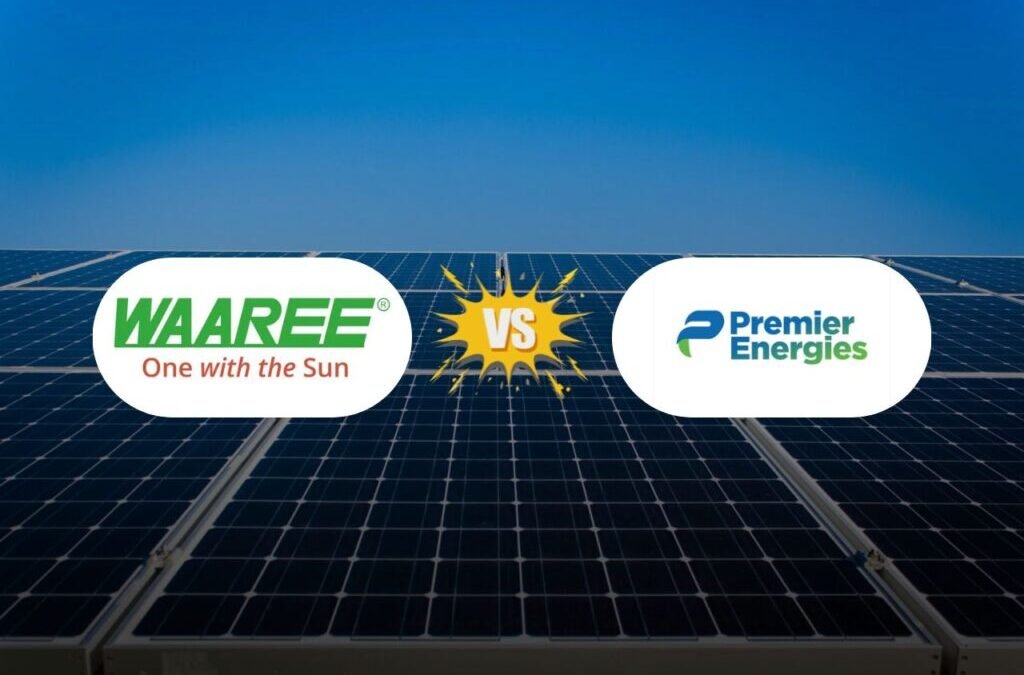India’s renewable energy landscape is undergoing rapid transformation, with solar and wind power expected to become increasingly cost-competitive compared to thermal power between 2025 and 2030. As of 2023, India ranked fourth globally in solar and wind power capacity, as well as in overall renewable energy installations.
With the fastest-growing renewable electricity market in the world, India is projected to double its new capacity additions by 2026. The country has set an ambitious target of achieving 450 GW of installed renewable energy capacity by 2030, with solar energy expected to contribute over 60 percent, around 280 GW.
In this fast-evolving sector, two companies, Waaree Energies Limited and Premier Energies Limited, have emerged as prominent players in solar manufacturing. While both operate in the same industry, they bring distinct strengths, strategies, and market positions. This article explores the key differences between them to better understand how each is contributing to and capitalising on India’s solar energy growth.
Founded in 1990, Waaree Energies Limited is India’s largest solar module manufacturer and leading renewable energy company. The company offers a wide range of solar solutions, including panel manufacturing, EPC services, project development, and rooftop solar systems.
As of FY25, Waaree has an installed solar module capacity of around 15 GW, with plans to add another 4.8 GW by FY26-27. It also operates 5.4 GW of solar cell capacity, and a 6 GW ingot and wafer facility is expected to be ready by FY27. Waaree holds a market-leading 14.1 percent share in India’s solar module shipments.
With a market cap of Rs. 85,935 crores, shares of Waaree Energies Limited moved up by nearly 1 percent on BSE to Rs. 3,013.75 on Friday. Listed in October 2024, the stock has since delivered positive returns of nearly 27 percent.
Premier Energies Limited, established in 1995, is another key player in India’s solar manufacturing sector. The company has expanded its solar cell manufacturing capacity from 2 GW to 3.2 GW.
With a total manufacturing capacity of 11.1 GW—including 6 GW currently under development—Premier focuses on integrated solar cell and module production. The company is backed by GEF Capital, a Washington D.C.-based private Equity Investor.
Shares of Premier Energies Limited surged nearly 1.5 percent to Rs. 1,069.05 on BSE, with a market cap of Rs. 47,795.6 crores. Listed in September 2024, the stock has since delivered positive returns of around 26 percent.
Order Book Status
As of the start of FY26, Waaree Energies reported a robust order book valued at nearly Rs. 47,000 crores, with a geographical split of 43 percent from India and 57 percent from overseas markets. The company currently has around 25 GW of confirmed orders and a substantial pipeline exceeding 100 GW. Premier Energies, on the other hand, reported an order book of Rs. 8,445.6 crore as of March 2025, up from Rs. 6,946.1 crore in December 2024.
The bulk of its order book, 73 percent, is driven by the solar module segment, followed by 27 percent from solar cells and a small 0.6 percent contribution from EPC projects. Premier’s business is largely focused on the domestic market, with 99 percent of its orders coming from within India and just 1 percent from exports, indicating a lower international exposure compared to Waaree.
Revenue Segmentation
In Q4 FY25, Waaree Energies derived around 88.4 percent of its consolidated revenue from Solar Photovoltaic (PV) Modules, 0.2 percent from the Generation of power, and the remaining 11.4 percent from Engineering, Procurement and Construction (EPC) contracts. Meanwhile, Premier Energies reports all its operating revenue under a single segment — Solar Products and related project activities.
Growth Guidance
Waaree Energies plans to expand its cell and module capacity by an additional 4.8 GW, while progressing steadily on its 6 GW integrated ingots-wafer-cell-module facility, part of a PLI project with a capex of Rs. 9,000 crore targeted for completion by FY27.
Its EPC arm, Waaree Renewable Technologies Ltd., is currently executing 3.2 GW worth of projects. Additionally, a 3 GW inverter manufacturing facility is expected to be on line by the end of FY26.
For FY26, the company has provided an EBITDA guidance of Rs. 5,500-6,000 crore, a notable increase from Rs. 3,123 crore in FY25. This projection is supported by a strong order book, robust execution capabilities, and an integrated value chain.
Waaree’s primary focus will remain on manufacturing (cells and modules) and EPC services during FY26, with contributions from its battery and green hydrogen segments expected to begin from FY27. Export sales are projected to make up around 17-22 percent of total revenue in FY26/27.
In contrast, Premier Energies is aiming to establish an integrated 10 GW manufacturing capacity across ingot, wafer, cell, and module segments by FY28. As part of its global growth plans, the company is prepared to invest in a 1.2 GW cell line in the US, pending policy clarity.
Over the next three years, Premier’s total capex plan is Rs. 12,500 crore, with the bulk of this capex allocated to setting up 4.8 GW of cell and 5.6 GW of module manufacturing lines—expected to be completed by the end of FY26 or early FY27.
Additional investments in battery energy storage systems (BESS) and inverter business will be phased in, with a focus on ramp-up during FY26 and FY27. Post-implementation, the company expects a fixed asset turnover ratio of 2.2x to 2.5x.
On the domestic front, Premier Energies has a healthy order book of 5.3 GW, with a similar or larger pipeline under discussion. These orders typically have a 12-14-month execution period. Capacity plans include scaling cell production to 8 GW by FY27—with a further increase to 10 GW by FY28—and module capacity reaching 11.1 GW by FY27.
In terms of specific capex breakdowns, the company estimates Rs. 400 crore per GW for ingot and wafer (Rs. 4,000 crore for 10 GW), Rs. 600 crore for a 12 GWh BESS facility, and Rs. 100-150 crore for inverters.
Financial Performance
Waaree Energies experienced a significant growth in its revenue from operations by around 36 percent YoY from Rs. 2,936 crores in Q4 FY24 to Rs. 4,004 crores in Q4 FY25, while the net profit jumped by about 36 percent YoY from Rs. 475 crores to Rs. 644 crores. Between FY22 and FY25, Waaree Energies’ revenue grew at a 3-year CAGR of nearly 72 percent, while net profit surged at a CAGR of ~189 percent.
On the other hand, Premier Energies also reported a growth in revenue from operations by around 44 percent YoY, from Rs. 1,127 crore in Q4 FY24 to Rs. 1,621 crore in Q4 FY25, while net profit jumped an impressive 167 percent YoY, from Rs. 104 crore to Rs. 278 crore. Its revenue grew at a 3-year CAGR of more than 106 percent between FY22 and FY25.
Written by Shivani Singh
Disclaimer

The views and investment tips expressed by investment experts/broking houses/rating agencies on tradebrains.in are their own, and not that of the website or its management. Investing in equities poses a risk of financial losses. Investors must therefore exercise due caution while investing or trading in stocks. Trade Brains Technologies Private Limited or the author are not liable for any losses caused as a result of the decision based on this article. Please consult your investment advisor before investing.
The post Waaree Energies vs Premier Energies: Which one should you buy? appeared first on Trade Brains.

